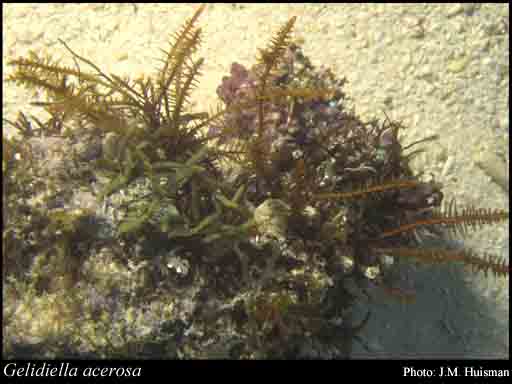- Reference
- Rev.Gén.Bot. 46:533 (1934)
- Conservation Code
- Not threatened
- Naturalised Status
- Native to Western Australia
- Name Status
- Current

Scientific Description
Habit and structure. Thallus yellow to dark red, cartilaginous, with decumbent and erect terete axes to 2 mm diam. Erect axes simple or sparingly divided, to 35 mm tall, bearing pinnate determinate lateral branches, mostly from the distal region. Lateral branches, simple, 1–3 mm long. Medulla of densely packed longitudinal filaments, the cells thick-walled and 10–25 µm diam., grading into a smaller-celled cortex of pigmented cells. Outer cortical cells ellipsoidal and forming a palisade, in surface view circular to slightly elongate, 3–8 µm diam.
Reproduction. Tetrasporangia in nemathecia encircling the distal regions of determinate lateral branches, in the outer cortical layer, ellipsoidal, c. 15 µm long and 8–9 µm diam.
Distribution. Widely distributed in tropical seas.
[After J.M. Huisman, G.H. Boo & S.M. Boo in Algae of Australia: Marine Benthic Algae of North-western Australia, 2. Red Algae: 255 (2018)]
Distribution
- IBRA Regions
- Carnarvon, Dampierland, Northern Kimberley, Pilbara.
- IBRA Subregions
- Cape Range, Mitchell, Pindanland, Roebourne.
- IMCRA Regions
- Central West Coast, Kimberley, Ningaloo, Pilbara (nearshore), Pilbara (offshore), Zuytdorp.
- Local Government Areas (LGAs)
- Ashburton, Broome, Carnarvon, Derby-West Kimberley, Exmouth, Karratha, Port Hedland, Shark Bay, Wyndham-East Kimberley.